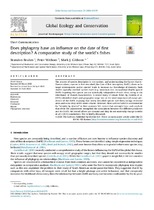| dc.contributor.author | Beukes, Brandon | |
| dc.contributor.author | Witbooi, Peter Joseph | |
| dc.contributor.author | Gibbons, Mark J. | |
| dc.date.accessioned | 2021-01-20T12:24:52Z | |
| dc.date.available | 2021-01-20T12:24:52Z | |
| dc.date.issued | 2020 | |
| dc.identifier.citation | Beukes, B. et al. (2020). Does phylogeny have an influence on the date of first description? A comparative study of the world's fishes. Global Ecology and Conservation, 23,e01078 | en_US |
| dc.identifier.issn | 2351-9894 | |
| dc.identifier.uri | 10.1016/j.gecco.2020.e01078 | |
| dc.identifier.uri | http://hdl.handle.net/10566/5707 | |
| dc.description.abstract | The process of species description is not random, and understanding the factors that influence when a species is first described (the date of first description, DoFD) allows us to target environments and/or species' traits to increase our knowledge of diversity. Such studies typically correlate species traits (e.g. maximum size, occupational depth) against DoFD, forgetting that species are not statistically independent of each other, owing to the inheritance of shared characteristics. A recent study of extant fishes by Costello et al. (2015) identified depth and geographic range size as the most important (of many) predictors of the DoFD, implying that newly described species will likely occupy restricted areas and occur deep in the water column. However, these authors failed to accommodate for “identity by descent” in their analyses. | en_US |
| dc.language.iso | en | en_US |
| dc.publisher | Elsevier | en_US |
| dc.subject | Biodiversity | en_US |
| dc.subject | Discovery | en_US |
| dc.subject | Estuarine | en_US |
| dc.subject | Freshwater | en_US |
| dc.subject | Marine | en_US |
| dc.title | Does phylogeny have an influence on the date of first description? A comparative study of the world's fishes | en_US |
| dc.type | Article | en_US |

